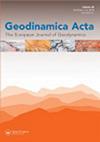Potential sources of Ediacaran strata of Iberia: a review
IF 1.5
Q1 Earth and Planetary Sciences
引用次数: 29
Abstract
Advances in stratigraphy, geochemistry and U-Pb detrital zircon geochronology from Ediacaran strata of Iberia allow for the improved characterisation of crustal growth in the North Gondwana active margin. The formation of Cadomian magmatic arcs and associated back-arc basins that took place in the North Gondwana active margin was a long-term process. Iberia has been placed in the Cadomian belt in currently accepted palaeogeography reconstructions at c. 570–560 Ma, based on the characteristics of Ediacaran strata. The Ediacaran strata of Iberia with outstanding geochemical homogeneity are distributed across three zones of Iberia: (1) Narcea Slates in the Cantabrian and West Asturian Leonese zones (maximum depositional age of c. 600 and 553 Ma); (2) Schist–Greywacke Complex (Lower Series) in the Central Iberian Zone (maximum depositional age of c. 578 to 550 Ma); and (3) Série Negra in the Ossa-Morena Zone (maximum depositional age of c. 590–545 Ma). Pre-Cryogenian detrital zircons found in the Ediacaran strata of Iberia seem to be related to distal sources distributed across three main areas of North Gondwana inland. The oldest detrital zircons probably derive from distal sources such as the West African craton, the Trans-Saharan belt and the Arabian–Nubian Shield, in view of the increase in distance from sedimentary basins. The West African craton is the most likely source for Archean and Palaeoproterozoic detrital zircons, while the Trans-Saharan belt and the Arabian–Nubian shield could provide a source for Tonian and Mesoproterozoic grains. The youngest zircon ages (c. 630–545 Ma), which make up the dominant population in the Ediacaran strata of Iberia, are probably derived from proximal sources as would be the Cadomian magmatic arc system, not excluding the contribution of the Pan-African orogen.伊比利亚地区埃迪卡拉系地层的潜在物源综述
来自伊比利亚埃迪卡拉系地层的地层学、地球化学和U-Pb碎屑锆石年代学的进展使得对北冈瓦纳活动边缘地壳生长特征的描述得到了改进。北冈瓦纳活动边缘卡多明期岩浆弧及其弧后盆地的形成是一个长期的过程。根据埃迪卡拉纪地层特征,在目前公认的约570-560 Ma古地理重建中,伊比利亚被置于卡多米安带。伊比利亚埃迪卡拉系地层地球化学均匀性突出,分布在伊比利亚的3个带中:(1)Cantabrian和West Asturian Leonese带的Narcea板岩(最大沉积年龄分别为约600 Ma和553 Ma);(2)伊比利亚中部片岩-灰瓦克杂岩(下系列)(最大沉积年代约578 ~ 550 Ma);(3) Ossa-Morena带ssamrie Negra(最大沉积年龄约590 ~ 545 Ma)。在伊比利亚埃迪卡拉纪地层中发现的前低温纪碎屑锆石似乎与分布在北冈瓦纳内陆三个主要地区的远端来源有关。考虑到与沉积盆地的距离增加,最古老的碎屑锆石可能来自远端,如西非克拉通、跨撒哈拉带和阿拉伯-努比亚盾。西非克拉通是太古宙和古元古代碎屑锆石最可能的来源,而跨撒哈拉带和阿拉伯-努比亚盾可能是Tonian和中元古代碎屑锆石的来源。最年轻的锆石年龄(约630-545 Ma)在伊比利亚的埃迪卡拉系地层中占主导地位,可能是来自近源的卡多米亚岩浆弧系统,不排除泛非造山带的贡献。
本文章由计算机程序翻译,如有差异,请以英文原文为准。
求助全文
约1分钟内获得全文
求助全文
来源期刊

Geodinamica Acta
地学-地球科学综合
CiteScore
4.50
自引率
0.00%
发文量
0
审稿时长
25 weeks
期刊介绍:
Geodinamica Acta provides an international and interdisciplinary forum for the publication of results of recent research dealing with both internal and external geodynamics. Its aims to promote discussion between the various disciplines that work on the dynamics of the lithosphere and hydrosphere. There are no constraints over themes, provided the main thrust of the paper relates to Earth''s internal and external geodynamics. The Journal encourages the submission of papers in all fields of earth sciences, such as biostratigraphy, geochemistry, geochronology and thermochronology, geohazards and their societal impacts, geomorphology, geophysics, glaciology, igneous and metamorphic petrology, magmatism, marine geology, metamorphism, mineral-deposits and energy resources, mineralogy, orogeny, palaeoclimatology, palaeoecology, paleoceanograpgy, palaeontology, petroleum geology, sedimentology, seismology and earthquakes, stratigraphy, structural geology, surface processes, tectonics (neoteoctonic, plate tectonics, seismo-tectonics, Active tectonics) and volcanism.
Geodinamica Acta publishes high quality, peer-reviewed original and timely scientific papers, comprehensive review articles on hot topics of current interest, rapid communications relating to a significant advance in the earth sciences with broad interest, and discussions of papers that have already appeared in recent issues of the journal. Book reviews are also included. Submitted papers must have international appeal and regional implications; they should present work that would be of interest to many different specialists. Geographic coverage is global and work on any part of the world is considered. The Journal also publishes thematic sets of papers on topical aspects of earth sciences or special issues of selected papers from conferences.
 求助内容:
求助内容: 应助结果提醒方式:
应助结果提醒方式:


